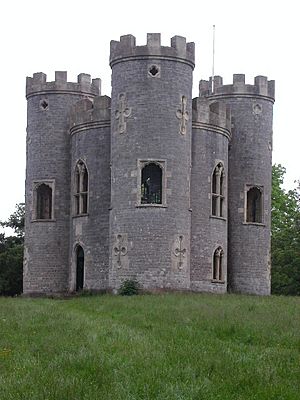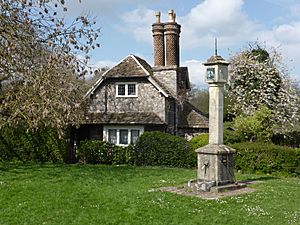Blaise Castle Estate facts for kids
Quick facts for kids Blaise Castle Estate |
|
|---|---|

The folly castle
|
|
| Location | Bristol, England |
| Built for | John Harford (Blaise Castle House) |
| Architect | William Paty (Blaise Castle House) |
| Owner | Bristol City Council |
|
Listed Building – Grade II*
|
|
| Official name: Blaise Castle | |
| Designated | 8 January 1959 |
| Reference no. | 1208115 |
|
Listed Building – Grade II*
|
|
| Official name: Blaise Castle House and attached wall | |
| Designated | 8 January 1959 |
| Reference no. | 1279500 |
| Official name: Blaise Castle and Hamlet | |
| Designated | 15 May 1987 |
| Reference no. | 1001426 |
|
Listed Building – Grade II
|
|
| Official name: Orangery to Blaise Castle House | |
| Designated | 8 January 1959 |
| Reference no. | 1293345 |
|
Listed Building – Grade II*
|
|
| Official name: Model dairy approximately 60 metres east of Blaise Castle House | |
| Designated | 8 January 1959 |
| Reference no. | 1293355 |
| Lua error in Module:Location_map at line 420: attempt to index field 'wikibase' (a nil value). | |
Blaise Castle is a fun, fake castle built in 1766 near Henbury in Bristol, England. It's called a "folly" because it was built just for looks, not for defense. This castle is part of the larger Blaise Castle Estate. The estate also includes Blaise Castle House, which is a beautiful old mansion from the 1700s.
The land where Blaise Castle Estate sits has a very long history. People lived here during the Stone Age, Bronze Age, Iron Age, and even Roman times. Today, the estate is owned by Bristol City Council. The main house is now a museum run by the Bristol City Museum and Art Gallery. You can see old clothes, toys, and household items there. The park around the castle is a great place to explore.
Contents
A Look at Early History
The Blaise Castle Estate has been home to people for thousands of years.
- Stone Age Farmers: Tiny pieces of flint found here suggest that early farmers lived on the land during the Stone Age.
- Bronze Age and Iron Age: There is clear proof of activity during the Bronze Age and Iron Age. This includes old hill-forts and other items found by archaeologists.
- Roman Times: Romans also used this area. All these historical signs show how important this landscape is.
In 1982, the estate became a scheduled monument. This means it's a special historical site protected by the government.
From Church Land to Private Estate
Long ago, before the Norman conquest, the land belonged to the Bishop of Worcester. There was a small church or chapel on the estate. This chapel was dedicated to Saint Blaise, which is how the estate got its name.
Later, after the Dissolution of the Monasteries, the land was sold. It changed hands many times over the centuries. In 1762, a sugar merchant named Thomas Farr bought the estate. He was the one who decided to build the fake castle.
Blaise Castle House
Blaise Castle House is the main mansion on the estate. It was built for a wealthy merchant and banker named John Harford. He bought the estate in 1789 and had the old house torn down. The new house was finished between 1796 and 1798. It was designed by an architect named William Paty.
The house is a large, square stone building. It has a grand entrance with tall columns. Later, in the early 1800s, a connected conservatory or orangery was added. This was a special room for growing plants. In the 1830s, a Picture Room was built to display paintings. Today, this room still shows off art from the Bristol City Museum and Art Gallery.
A Museum for Everyone
The Harford family lived in Blaise Castle House until 1926. Then, Bristol City Council bought the estate. They wanted to make sure the beautiful park and buildings were saved for everyone to enjoy.
Since 1949, Blaise Castle House has been a branch of the Bristol City Museum and Art Gallery. It's a great place to learn about how people lived in the past. You can see old household items like lamps, cooking tools, and cleaning supplies. There are also displays of historic costumes and toys from the 1700s to the 1980s.
The Folly Castle
On a hill overlooking Bristol, you'll find the famous Blaise Castle. This is the "sham castle" or "folly" that was built in 1766. It was designed by Robert Mylne. The castle is made of local stone and has three towers with jagged tops, like a real medieval castle.
From the castle, you can see amazing views of Bristol, the Avonmouth area, and the Avon Gorge. On a clear day, you can even see across to South Wales! The castle was very popular with visitors from the start. People loved to come and enjoy the views. The famous author Jane Austen even mentioned the castle in her novel Northanger Abbey.
The castle was used for fun and viewing until the 1900s. It was fixed up in 1957 and is now a protected historic building.
Blaise Hamlet

Blaise Hamlet is a charming group of nine small cottages. They are built around a village green. The hamlet was created around 1811 for John Harford's retired employees. It was designed by the famous architect John Nash.
Each cottage in Blaise Hamlet is unique. They have different chimneys, windows, and some even have cozy thatched roofs. Nash designed them in a "picturesque" style, which means they look like they belong in a beautiful painting. An oval path connects all the cottages, and there's a sundial in the middle of the green. The gardens around the cottages are planted in a lovely old-fashioned style.
Exploring the Estate Grounds
The Blaise Castle Estate covers about 650 acres (2.6 square kilometers) of parkland. It's now open to the public, so everyone can enjoy its beauty. The parkland is also a protected historic site.
The famous landscape gardener Humphry Repton designed parts of the grounds in the early 1800s. Some of his original designs, like the winding carriage drive, can still be seen today.
Natural Wonders and Features
The estate has a deep gorge carved by the Hazel Brook stream. This gorge has some cool natural features:
- Goram's Chair: A limestone rock formation that climbers sometimes use.
- Lover's Leap and Potter's Point: Two spots with amazing panoramic views.
There's also an old mill called Stratford Mill. It was moved here from another location and rebuilt in the gorge. The Hazel Brook stream eventually joins the River Trym, which flows towards Sea Mills.
Other interesting spots in the estate include two pools, the Giant's Soapdish and the Penny Well. There are also two caves, the Robber's Cave and the Butcher's Cave, which add to the mystery and fun of exploring the grounds.
See also



